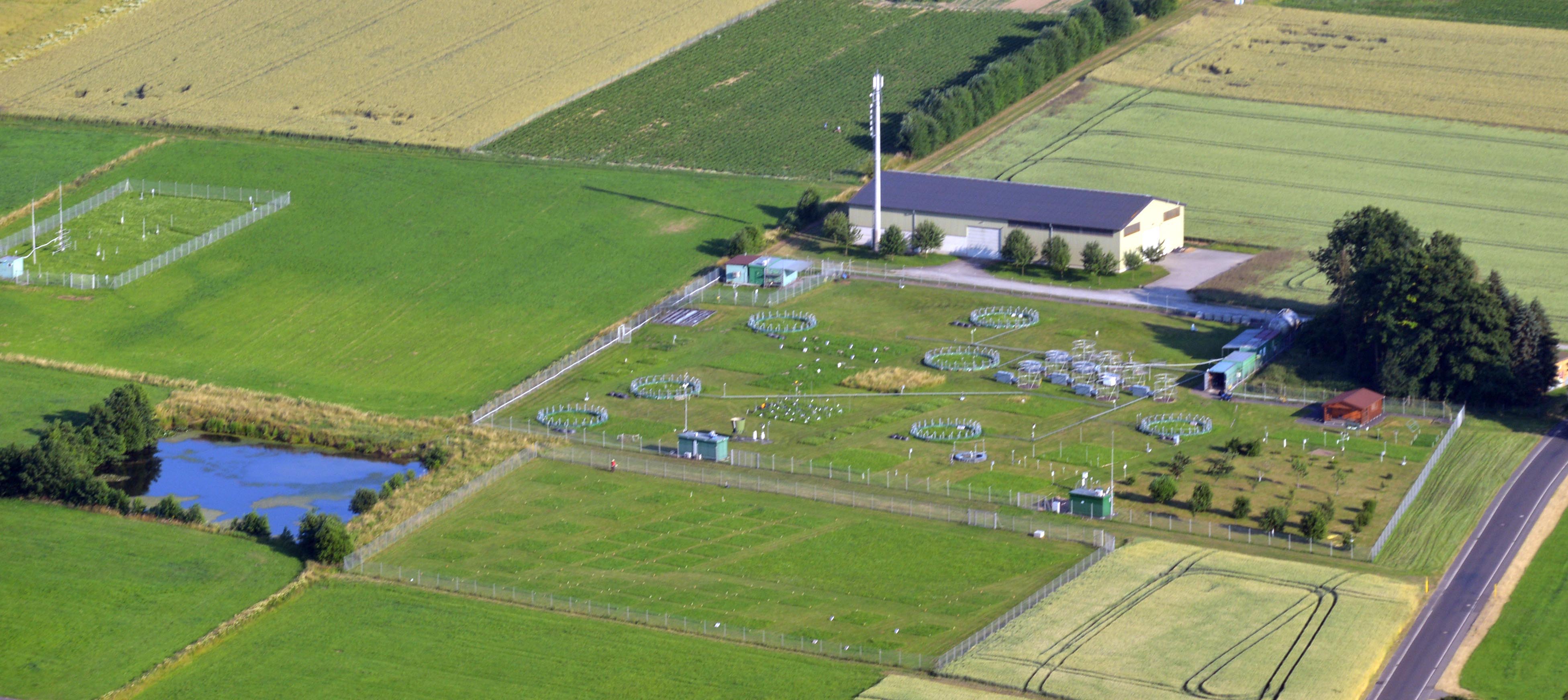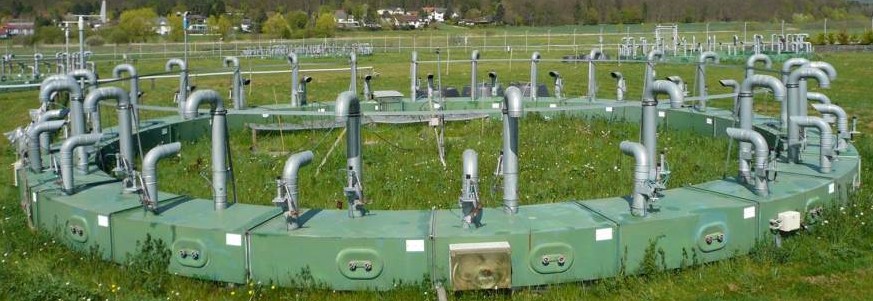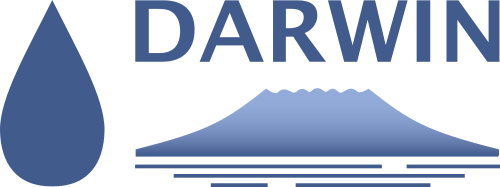FACE2FACE - Effects from climate change, adaptions and greenhouse gas reduction [funded by LOEWE] - Status: closed
Project staff:
Prof. Dr. Jörg Bendix
Abstract:
Rising atmospheric greenhouse gas concentrations from anthropogenic activities are a major driver of global climate change. The increase in atmospheric carbon dioxide (CO2) concentrations may stimulate plant photosynthesis. As a consequence of this enhanced photosynthesis, an increase in the net primary productivity (NPP) of C3 plants (termed CO2 fertilization) is widely assumed. This process is assumed to be associated with a reduced stomatal conductance of leaves as the carbon demand of photosynthesis is met earlier. This causes a higher water-use efficiency and, hence, may reduce water stress in plants exposed to higher CO2 concentrations. However, the magnitude and persistence of the CO2 fertilization effect under a future climate including more frequent weather extremes remains controversial.
In the "Giessener Free Air Carbon dioxide Enrichment” (GiFACE) experiment, plots of a temperate grassland receive an CO2 enriched air (~ 20% higher than ambient conditions) since 1998. This allows to analyse the CO2 fertilization effect under naturally occurring climate variations and over long term which enables the derivation of statistical models about climate change consequences.


Description:
Inititally, we develop a statistical approach which enables the analysis of the CO2 effect dependent on the interacting effects of ambient abiotic factors (e.g. hot and dry weather conditions)
Moreover, we conduct hyperspectral measurements for the noninvasive monitoring of above-ground vegetation parameters. Thus, the influences of an increased CO2 (and/or temperature for new FACE facility) on production/ecophysiology of the plants is derived. The derived parameters can be used for projecting changes in vegetation and their characteristics with e.g. dynamic models. Moreover, the field measurements in combination with the laboratory results enable the derivation of transferfunctions (e.g. Narrow-Band Analysis, PLS regression) with parameters of production and ecophysiologiy (e.g. for biodiversity, biomass, leaf area index, chlorophyll, nitrogen, phosphorus, potassium). Once derived, the transfer functions will be upscaled to multi- and hyperspectral remote sensors (satellites), enabling the analysis of the aboveground plant characteristics from space.
Further infos: https://www.uni-giessen.de/fbz/fb08/Inst/pflanzenoek/face2face
Datawarehouse: http://face2face.center
Publications and poster presentations:
2019 - Obermeier, W.; Lehnert, L.; Pohl, M.; Gianonni, S.M.; Silva, B.; Seibert, R.; Laser, H.; Moser, G.; Müller, C.; Luterbacher, J. & Bendix, J. (2019): Grassland ecosystem services in a changing environment: The potential of hyperspectral monitoring. Remote Sensing of Environment 232, 111273.
2018 - Yuan, N.; Moser, G.; Müller, C.; Obermeier, W.; Bendix, J. & Luterbacher, J. (2018): Extreme climatic events down- regulate the grassland biomass response to elevated carbon dioxide. Nature Scientific Reports 8, 17758.
- Obermeier, W.; Lehnert, L.; Ivanov, M.; Luterbacher, J. & Bendix, J. (2018): Reduced summer aboveground productivity in temperate C3 grasslands under future climate regimes. Earth's Future 6(5), 716-729.
2017 - Obermeier, W.; Lehnert, L.; Ivanov, M.; Luterbacher, J. & Bendix, J. (2017-10-28). Verringerte Produktivität gemäßigter Grünländer im Sommer unter zukünftigen Klimaregimen. Presented at Annual Meeting of the working group "Climate" of the DGfG, Rauischholzhausen.
- Obermeier, W.; Lehnert, L.; Kammann, C.; Müller, C.; Grünhage, L.; Luterbacher, J.; Erbs, M.; Moser, G.; Seibert, R.; Yuan, N. & Bendix, J. (2017-10-10). Extremere Wetterbedingungen reduzieren den CO 2 -Düngungseffekt in Grünländern der gemäßigten Breiten. Presented at FACE2FACE closing event, Geisenheim.
- Obermeier, W.; Lehnert, L.; Silva, B.; Otte, A.; Luterbacher, J.; Grünhage, L. & Bendix, J. (2017-10-10). Hyperspektrale Fernerkundung zur nicht-invasiven Erfassung von Pflanzeneigenschaften. Presented at FACE2FACE closing event, Geisenheim.
- Obermeier, W.; Lehnert, L.; Kammann, C.; Müller, C.; Grünhage, L.; Luterbacher, J.; Erbs, M.; Moser, G.; Seibert, R.; Yuan, N. & Bendix, J. (2017): Reduced CO2 fertilization effect in temperate C3 grasslands under more extreme weather conditions. Nature Climate Change 7(2), 137-141.
2016 - Obermeier, W.; Lehnert, L.; Kammann, C.; Müller, C.; Grünhage, L.; Luterbacher, J.; Erbs, M.; Moser, G.; Seibert, R.; Yuan, N. & Bendix, J. (2016-09-26). Extreme weather conditions reduce the CO2 fertilization in temperate C3 grasslands. Presented at FACEing the future, Giessen.
- Obermeier, W.; Lehnert, L.; Kammann, C.; Müller, C.; Grünhage, L.; Luterbacher, J.; Erbs, M.; Yuan, N. & Bendix, J. (2016-04-18). Extreme weather conditions reduce the CO2 fertilization effect in temperate C3 grasslands. Presented at EGU, Vienna.




